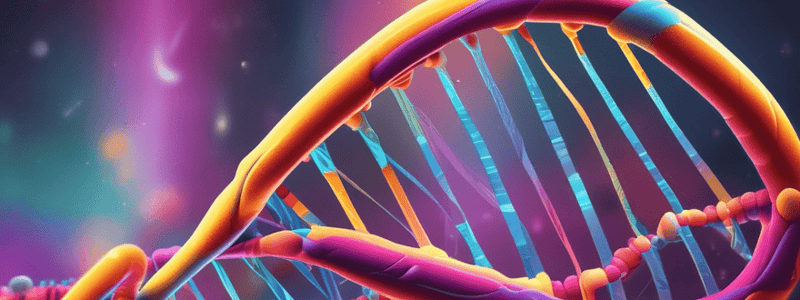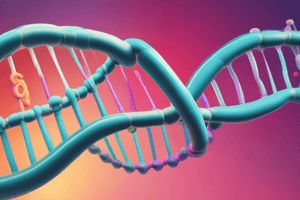Podcast
Questions and Answers
What did Frederick Griffith identify as the two strains of Pneumococcus?
What did Frederick Griffith identify as the two strains of Pneumococcus?
- S and R strains (correct)
- Rough and soft strains
- Smooth and rough strains
- Virulent and avirulent strains
In Griffith's transformation experiment, what could a single gene mutation change do?
In Griffith's transformation experiment, what could a single gene mutation change do?
- Enhance the antibiotic resistance of the strain
- Convert an avirulent strain to a virulent strain (correct)
- Alter the color of the bacterial colonies
- Convert a virulent strain to an avirulent strain
According to geneticists in the 1940s, what was favored as genetic material?
According to geneticists in the 1940s, what was favored as genetic material?
- Carbohydrates
- Proteins (correct)
- Nucleic acids
- Lipids
What did Hershey and Chase demonstrate in their experiment using Escherichia coli and bacteriophage T2?
What did Hershey and Chase demonstrate in their experiment using Escherichia coli and bacteriophage T2?
What type of sugar is present in DNA but not in RNA?
What type of sugar is present in DNA but not in RNA?
What did Rosalind Franklin's X-ray diffraction studies reveal about DNA structure?
What did Rosalind Franklin's X-ray diffraction studies reveal about DNA structure?
Which scientist's base composition analysis provided crucial data to Watson and Crick for their DNA model?
Which scientist's base composition analysis provided crucial data to Watson and Crick for their DNA model?
According to Watson and Crick's model, how are the two DNA strands connected?
According to Watson and Crick's model, how are the two DNA strands connected?
What did Watson and Crick propose about the structure of DNA?
What did Watson and Crick propose about the structure of DNA?
What was the Nobel Prize awarded to James Watson and Francis Crick for in 1962?
What was the Nobel Prize awarded to James Watson and Francis Crick for in 1962?
What are the four key characteristics that the genetic material must exhibit?
What are the four key characteristics that the genetic material must exhibit?
Which two scientists independently described the parallels between chromosome partitioning into gametes and the inheritance of genes?
Which two scientists independently described the parallels between chromosome partitioning into gametes and the inheritance of genes?
What was the evidence that made DNA a candidate for the hereditary material?
What was the evidence that made DNA a candidate for the hereditary material?
In what year were Mendel's hereditary principles rediscovered?
In what year were Mendel's hereditary principles rediscovered?
How many hydrogen bonds are formed between a guanine (G) and cytosine (C) base pair?
How many hydrogen bonds are formed between a guanine (G) and cytosine (C) base pair?
Which of the following statements about the DNA structure is correct?
Which of the following statements about the DNA structure is correct?
Which of the following experiments provided evidence for the structure of DNA?
Which of the following experiments provided evidence for the structure of DNA?
What is the significance of Chargaff's rules of base composition in the discovery of the DNA structure?
What is the significance of Chargaff's rules of base composition in the discovery of the DNA structure?
Who were awarded the Nobel Prize in 1962 for their contribution to the discovery of the DNA structure?
Who were awarded the Nobel Prize in 1962 for their contribution to the discovery of the DNA structure?
Study Notes
Griffith's Transformation Experiment
- Frederick Griffith identified two strains of Pneumococcus: S (smooth) and R (rough)
- S strain is virulent and causes fatal pneumonia in mice, while R strain is avirulent
- A single gene mutation can convert an S strain to an R strain
The Avery, MacLeod, and McCarty Experiment
- Experiment in 1944 showed that DNA is the hereditary molecule
- Provided foundation for understanding the transforming principle
Hershey-Chase Experiment
- Experiment in 1952 used Escherichia coli and bacteriophage T2
- Used radioisotopes 32P and 35S to demonstrate DNA enters bacterial cell during infection and directs viral reproduction
- Demonstrated that DNA, not protein, is the genetic material
Structure of DNA
- Nucleotides consist of a nitrogenous base, pentose sugar, and phosphate group
- Nucleosides contain nitrogenous base and pentose sugar
- Nucleotides are linked by phosphodiester bonds between phosphate group at C-5' position and OH group on C-3' position
Erwin Chargaff's Rules of Base Composition
- The amount of T = A, the amount of C = G
- The amount of pyrimidine nucleotides (T+C) = purine nucleotides (A+G)
Rosalind Franklin's X-ray Diffraction Analysis
- X-ray diffraction analysis of DNA showed a 3.4-angstrom periodicity, characteristic of a helical structure
- Data provided crucial information for Watson and Crick's model of DNA
Watson and Crick's Double Helix Model
- Proposed structure of DNA as a double helix with two anti-parallel strands connected by base pairing
- Stacked nitrogenous bases and sugar-phosphate backbone form the structure of DNA
Studying That Suits You
Use AI to generate personalized quizzes and flashcards to suit your learning preferences.
Related Documents
Description
This quiz covers topics related to DNA structure, replication, nucleic acid chemistry, evidence supporting DNA as the genetic material, RNA structure, and criteria for genetic material. It also includes information about Mendel's rediscovery.




